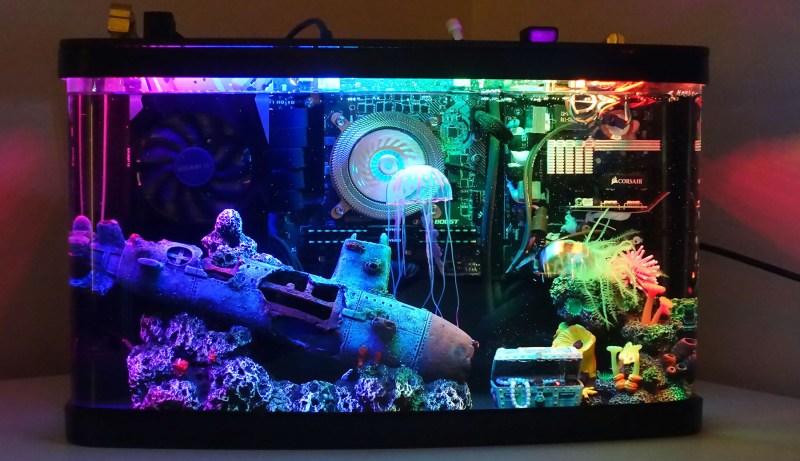Aquariums are amazingly beautiful displays of vibrant ocean life, or at least they can be. For a lot of people aquariums become frustrating chemistry battle to keep the ecosystem heathly and avoid a scummy cesspool where no fish want to be.
This hack sidesteps that problem, pulling off some of the most beautiful parts of a living aquarium, while keeping your gaming rig running nice and cool. That’s right, this tank is a cold mineral oil dip for a custom PC build.
It’s the second iteration [Frank Zhao] has built, with many improvements along the way. The first aquarium computer was shoe-horned inside of a very tiny aquarium — think the kind for Beta fish. It eventually developed a small crack that spread to a bigger one with a lot of mineral oil to clean up. Yuck. The new machine has a much larger tank and laser cut parts which is a step up from the hand-cut acrylic of the first version. This makes for a very nice top bezel that hangs the PC guts and provides unobtrusive input and output ports for the oil circulation. A radiator unit hidden out of sight cools the oil as it circulates through the system.
These are all nice improvements, but it’s the aesthetic of the tank itself that really make this one special. The first version was so cramped that a couple of sad plastic plants were the only decoration. But now the tank has the whole package, with coral, more realistic plants, a sunken submarine, and of course the treasure chest bubbler. Well done [Frank]!
















Wheres the fish?
https://www.amazon.ca/dp/B07B5Z43GK/
I think you should add some more affiliate referrers to that link
I sanitized the link that was shared to remove all of those referrer codes.
Thank you.
I’ve always wanted to see if an AIO pump block (not connected to anything as it only circulates the oil in its vicinity) can be used as a “heatsink” in a mineral oil cooled PC given that the oil is actively cooled externally. Reason is these AIO pump blocks are smaller and looks good, and way smaller than heatsinks.
General recommendation to anyone building a mineral oil cooled PC.
Don’t use a regular aquarium! Glass do survive mineral oil, but the silicone adhesive used in aquariums doesn’t.
And for acrylic aquariums using cyanoacrylate glue to “weld” it all together is a far better option, due to acrylic and acrylic glue both surviving mineral oil just fine.
But most people forget the forces at play when dealing with a couple of gallons of oil, and select thin acrylic as the construction material. typically around 5-8 mm. (Like a glass aquarium of the same size.) But forgetting how much more flexible and crack prone acrylic is compared to glass. My recommendation is to use at least twice as thick acrylic as a glass aquarium of the same volume. (Preferably thicker if you plan on moving it while full of oil.)
And for those thinking of using glass and cyanoacrylate glue, then here’s a spoiler, cyanoacrylate glue and glass doesn’t bind all that well…. Especially with a bit of temperature cycling since they have wildly different rates of thermal expansion.
looks great frank!
If you don’t want to use mineral oil; try automatic transmission fluid
Do NOT use mineral oil! A: It dissolves rubber. B: It creates toxic VOC when heated.
You need to be using something like 3M Novec fluid.
Hey Tefen,
I’d like for my PC classes to build one of these. What level of Novec Fluid would you use? I see 3M Novec 7500 Engineered Fluid is used for less than 200 C and can be used for immersion cooling.